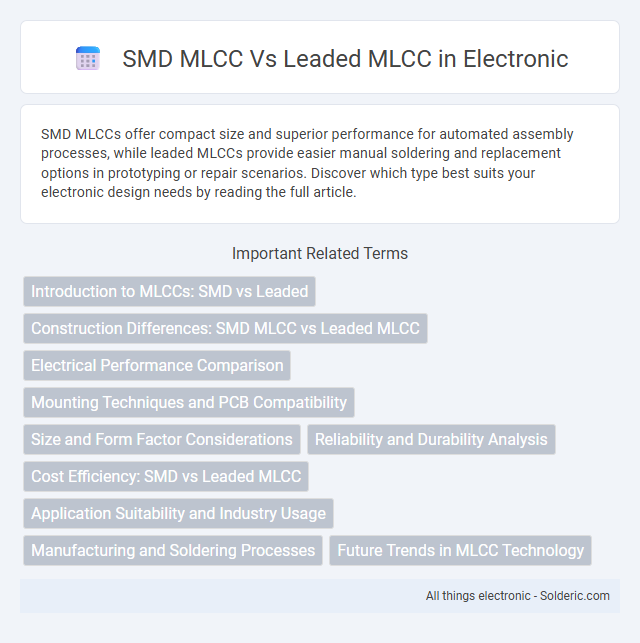SMD MLCCs offer compact size and superior performance for automated assembly processes, while leaded MLCCs provide easier manual soldering and replacement options in prototyping or repair scenarios. Discover which type best suits your electronic design needs by reading the full article.
Comparison Table
| Feature | SMD MLCC | Leaded MLCC |
|---|---|---|
| Mounting Type | Surface Mount Technology (SMT) | Through-Hole Technology (THT) |
| Size | Compact, smaller footprint | Larger, bulkier design |
| Assembly | Automated PCB assembly | Manual or wave soldering |
| Reliability | High vibration and shock resistance | Moderate mechanical strength |
| Capacitance Range | Wide range (pF to uF) | Similar range, limited by size |
| Inductance | Lower parasitic inductance | Higher parasitic inductance |
| Application | High-density, automated electronics | Prototyping, through-hole legacy systems |
| Cost | Generally lower cost in large volumes | Higher cost due to manual assembly |
Introduction to MLCCs: SMD vs Leaded
Surface-mount device (SMD) multilayer ceramic capacitors (MLCCs) offer compact size, higher capacitance per volume, and suitability for automated assembly compared to leaded MLCCs, which have through-hole leads and are typically larger with easier manual handling. SMD MLCCs are preferred in high-density electronic circuits due to their lower parasitic inductance and improved high-frequency performance, while leaded MLCCs remain common in applications requiring mechanical robustness and simpler prototype testing. Both types utilize ceramic dielectric layers but differ significantly in mounting technology, affecting assembly processes and electrical characteristics.
Construction Differences: SMD MLCC vs Leaded MLCC
SMD MLCCs feature a compact, rectangular ceramic body with terminations on two opposite ends designed for surface mounting, whereas leaded MLCCs have wire leads extending from the ceramic body for through-hole mounting. The construction of SMD MLCCs allows for automated placement on PCBs, improving manufacturing efficiency and enabling higher circuit densities compared to leaded types. Leaded MLCCs, by contrast, offer easier manual soldering and repair, making them preferable in prototyping or applications requiring robust mechanical connections.
Electrical Performance Comparison
SMD MLCCs offer superior high-frequency performance and lower equivalent series inductance (ESL) compared to leaded MLCCs, making them ideal for compact, high-speed circuits. Your choice impacts signal integrity, as SMD MLCCs provide better capacitance stability under varying temperature and voltage conditions. Leaded MLCCs tend to have higher parasitic inductance, which can degrade electrical performance in advanced electronic applications.
Mounting Techniques and PCB Compatibility
SMD MLCCs utilize surface-mount technology that allows them to be directly placed and soldered onto PCB pads, providing higher automation compatibility and reduced assembly time. Leaded MLCCs, designed with wire leads, require through-hole mounting that involves inserting leads into drilled PCB holes, making them suitable for manual assembly and prototyping but less efficient for high-volume production. Your choice between these MLCC types should consider PCB design constraints and the desired manufacturing process efficiency.
Size and Form Factor Considerations
SMD MLCCs offer significantly smaller size and more compact form factors compared to leaded MLCCs, enabling higher component density on printed circuit boards (PCBs). The surface-mount design eliminates the need for leads, allowing for thinner profiles and more efficient use of PCB real estate in miniaturized electronic devices. This size reduction supports advanced applications in smartphones, wearables, and other space-constrained technologies where board space optimization is critical.
Reliability and Durability Analysis
SMD MLCCs exhibit superior reliability and durability due to their compact size, reduced inductance, and enhanced thermal performance compared to leaded MLCCs, which are more prone to mechanical stress and solder joint fatigue. The surface-mount design minimizes the risk of cracking under thermal cycling, extending operational lifespan in high-vibration and high-temperature environments. Leaded MLCCs, while easier to replace, often suffer from lower resistance to mechanical shock and inferior long-term stability in demanding electronic applications.
Cost Efficiency: SMD vs Leaded MLCC
SMD MLCCs generally offer greater cost efficiency compared to leaded MLCCs due to lower material usage, automated assembly compatibility, and reduced labor costs, making them ideal for high-volume production. Leaded MLCCs, although often more robust for certain applications, tend to incur higher manufacturing and handling expenses because of manual assembly requirements. Your choice of capacitor should balance cost efficiency with performance needs specific to your project demands.
Application Suitability and Industry Usage
SMD MLCCs (Surface-Mount Device Multilayer Ceramic Capacitors) are highly suitable for compact, high-density electronic designs commonly found in consumer electronics, automotive, and telecommunications industries due to their miniaturized form factor and automated assembly compatibility. Leaded MLCCs, with through-hole mounting, are preferred in industrial, military, and aerospace applications where robust mechanical stability and ease of manual soldering are critical. Industry usage thus diverges, with SMD MLCCs dominating mass-produced, space-constrained devices, while leaded MLCCs serve niche markets requiring durability and repairability.
Manufacturing and Soldering Processes
SMD MLCCs are manufactured using automated pick-and-place machines that enable precise placement on PCB surfaces, facilitating high-speed reflow soldering with solder paste. Leaded MLCCs require through-hole mounting, involving manual or wave soldering processes that typically have higher thermal stress and longer cycle times. The choice between surface mount and leaded components significantly impacts assembly efficiency, solder joint reliability, and overall manufacturing throughput.
Future Trends in MLCC Technology
SMD MLCCs dominate future trends with advancements in miniaturization, enhanced capacitance density, and improved reliability for mobile devices and IoT applications. Leaded MLCCs are gradually phased out due to environmental regulations and limited integration potential in compact electronics. Emerging materials and fabrication techniques prioritize SMD MLCCs for next-generation high-frequency and high-temperature performance demands.
SMD MLCC vs leaded MLCC Infographic

 solderic.com
solderic.com